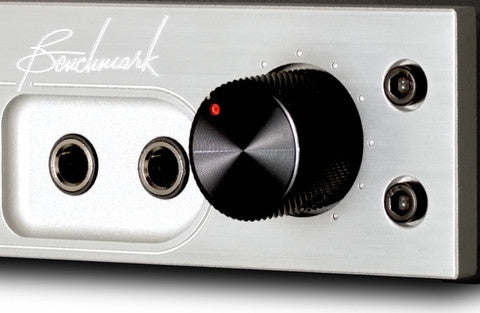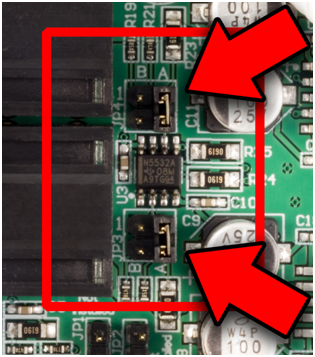Buy 2 components and get 4 free cables. Free shipping on all orders over $700.
Will the HPA2 Drive My Headphones?
by John Siau February 04, 2016

Will the HPA2™ Drive My Headphones?
Benchmark DAC1 and DAC2 converters are equipped with Benchmark’s HPA2™ headphone power amplifier. This is a high-current design with very low output impedance (less than 0.1 Ohms). It is capable of driving a wide variety of headphones while achieving extraordinarily low distortion. The full rated performance of the DAC1 is achieved at the headphone jack while driving two sets of headphones. THD+N is less than 0.0003% under full load. The HPA2™ may be the quietest and cleanest headphone amplifier available.
 The HPA2™ also has sufficient output level to drive any headphone well beyond normal listening levels. For this reason, the HPA2™ in the DAC1 USB is equipped with gain programming jumpers that can be used to reduce the gain by 10 dB. We recommend using the 10 dB attenuation setting with the Sennheiser headphones.
The HPA2™ also has sufficient output level to drive any headphone well beyond normal listening levels. For this reason, the HPA2™ in the DAC1 USB is equipped with gain programming jumpers that can be used to reduce the gain by 10 dB. We recommend using the 10 dB attenuation setting with the Sennheiser headphones.
The HPA2™ in the DAC1 PRE, DAC1 HDR, DAC2 HGC, DAC2 D, and DAC2 DX converters has an additional 20 dB attenuation setting. This setting is recommended for high-sensitivity headphones. Headphones having a low input impedance (30 to 60 Ohms) often have high sensitivity and we recommend the 20 dB attenuation setting for these headphones.
The attenuation is inserted before the HPA2™ headphone amplifier. This attenuator location keeps the output impedance of the HPA2™ constant and very near 0 Ohms. External attenuators should never be inserted after a headphone amplifier as this would change the output impedance.
Proper attenuator settings are important for maximizing the SNR of the headphone monitoring system. With proper settings, the full performance of the DAC2 can be delivered to the headphones for critical monitoring tasks, or maximum musical enjoyment.
When the headphone attenuation jumpers are set properly, a normal listening level will be achieved between the 10 o'clock and 2 o'clock volume control positions. If a normal listening level is achieved below a 10 o’clock volume-control position, the headphone gain is too high, and the attenuation should be increased. If the level is too low at a 2 o'clock volume control position, the headphone gain is too low, and the attenuation should be decreased.
The 0-Ohm output impedance provides outstanding control of the headphone drivers. This improves bass damping, reduces distortion, and flattens the frequency response.
DAC1 and DAC2 converter families were designed from the ground up to be headphone amplifiers with line outputs. The large power supplies in the DAC1 and DAC2 converters are necessary to support the demanding power requirements of the HPA2™ headphone power amplifier.
Additional reading:
More information on headphones and headphone amplifiers can be found here.
Also in Audio Application Notes

Audiophile Snake Oil
by John Siau April 05, 2024
The Audiophile Wild West
Audiophiles live in the wild west. $495 will buy an "audiophile fuse" to replace the $1 generic fuse that came in your audio amplifier. $10,000 will buy a set of "audiophile speaker cables" to replace the $20 wires you purchased at the local hardware store. We are told that these $10,000 cables can be improved if we add a set of $300 "cable elevators" to dampen vibrations. You didn't even know that you needed elevators! And let's not forget to budget at least $200 for each of the "isolation platforms" we will need under our electronic components. Furthermore, it seems that any so-called "audiophile power cord" that costs less than $100, does not belong in a high-end system. And, if cost is no object, there are premium versions of each that can be purchased by the most discerning customers. A top-of-the line power cord could run $5000. One magazine claims that "the majority of listeners were able to hear the difference between a $5 power cable and a $5,000 power cord". Can you hear the difference? If not, are you really an audiophile?

Making Sound with Plasma - Hill Plasmatronics Tweeter
by John Siau June 06, 2023
At the 2023 AXPONA show in Chicago, I had the opportunity to see and hear the Hill Plasmatronics tweeter. I also had the great pleasure of meeting Dr. Alan Hill, the physicist who invented this unique device.
The plasma driver has no moving parts and no diaphragm. Sound is emitted directly from the thermal expansion and contraction of an electrically sustained plasma. The plasma is generated within a stream of helium gas. In the demonstration, there was a large helium tank on the floor with a sufficient supply for several hours of listening.

While a tank of helium, tubing, high voltage power supplies, and the smell of smoke may not be appropriate for every living room, this was absolutely the best thing I experienced at the show!
- John Siau

Audio Calculators
by John Siau June 04, 2023
We have added an "Audio Calculators" section to our webpage. Click "Calculators" on the top menu to see more like these:

